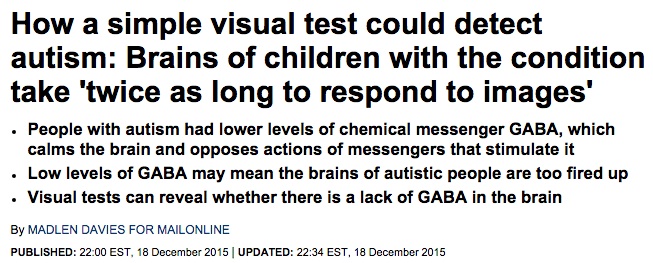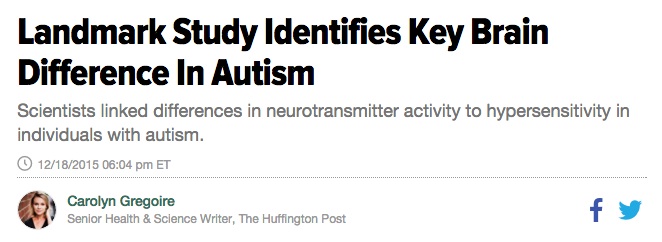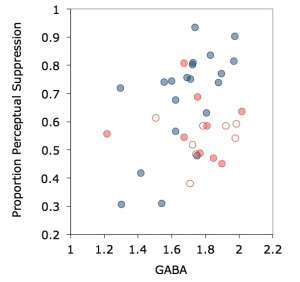Gamma aminobutyric acid (or GABA for short) is an inhibitory neurotransmitter – it makes a neuron less likely to fire. GABA is important, not only in damping down brain activity, but also in controlling the precise timing of the neural impulses. It allows groups of neurons to synchronize their activity and transmit signals across the brain.
In a 2001 paper, John P Hussman speculated that GABA might be implicated in autism. To date, the evidence has been fairly indirect. However, a paper published last week in Current Biology claims to provide the first direct evidence linking autism symptoms to GABA dysfunction.
Here’s the press release:
Harvard scientists for the first time have linked a specific neurotransmitter in the brain with autistic behavior. Using a visual test that prompts different reactions in autistic and normal brains, a research team led by Caroline Robertson, a junior fellow of the Harvard Society of Fellows, was able to show that those differences were associated with a breakdown in the signaling pathway used by GABA
Here’s how the Daily Mail covered the study:

And here’s the Huffington Post’s take:

So is the hype justified? I would argue not. At least not yet.

In the study, Robertson et al. used Magnetic Resonance Spectroscopy (MRS) to measure GABA levels of 17 adolescents and young adults with autism and 20 age-matched control participants [1]. As far as participants are concerned, this is just like having a regular MRI scan, but the scanner is programmed differently so it can estimate the concentration of different chemicals in the brain.
Contrary to some of the coverage, there was no significant difference in GABA levels between the two groups [2].
Instead, the interesting results came when the authors looked at the relationship between the GABA levels of individual participants and their performance on a test of binocular rivalry.
Normally, our two eyes see the same objects but from a slightly different angle and our visual system can fuse these two images together to create a 3-d view of the world. But in binocular rivalry experiments, completely different images are presented to each eye. The visual system is unable to combine the two images, so instead participants tend to experience seeing one of the images at a time, flipping back and forth between which image is perceived and which is suppressed.

In Robertson et al.’s version of the binocular rivalry task, one image was red and the other was green. The participants had to press one of three buttons to say whether they could see the red image, the green image, or a mixture of the two. Compared with the control group, people with autism on average spent less time pressing either the “red” or “green” buttons (and more time pressing the “mixture” button). This suggests that they were less able to suppress the image from one eye.
However, as we can see, there was huge variation in performance, even in the control group. In fact, two of the control participants had suppression scores that were lower than any of the participants with autism. This, incidentally, suggests that any diagnostic test based on perceptual suppression would be next to useless [3].

In the control group, there was a strong correlation between this suppression measure and levels of GABA in the visual cortex. The higher their GABA, the more time they indicated they were perceiving only one image. This is consistent with previous studies of non-autistic people – and with the idea that GABA is involved in inhibiting the image from one eye to allow the other one to (momentarily) dominate perception.

However, this correlation was significantly weaker in the autism group. There was no relationship between GABA levels and performance on the binocular rivalry task. So how did the authors conclude that they had found a link between GABA and autistic behaviour?
Their argument, in essence, is that the absence of a correlation is itself evidence for atypical GABA functioning.
In the introduction to the paper, they set up this line of reasoning as follows:
Given prior evidence from genetic, animal, and post-mortem studies, we hypothesized that inhibitory signaling may be affected in the autistic brain. This disruption could take the form of reduced levels of GABA or glutamate. However, reports of perturbations of key components of the GABA signaling pathway, such as receptors and inhibitory neuronal density, suggest that GABA levels themselves may not be altered in autism but instead may be less predictive of rivalry dynamics.
The idea then is that GABA levels are normal, but perception in the binocular rivalry task is affected by some other aspect of GABA functioning that Magnetic Resonance Spectroscopy doesn’t measure. This in turn means that the “normal” relationship between GABA levels and perceptual suppression no longer holds.
It’s certainly an interesting and – I think – plausible explanation of the results. It would be neat if it was true. But before accepting this explanation, we have to eliminate a number of alternatives.
First, it’s important to note that there are only 17 participants with autism in the final analysis. With a sample size that small, there’s a very good chance of not finding a correlation, even if there is a completely normal relationship between GABA levels and perceptual suppression in autism. As the authors note, the study really needs to be replicated. Until it is (and the same pattern reported), we really have to withhold judgement.
Second, we should consider the possibility that (some) people with autism are performing the binocular rivalry task differently to the non-autistic controls. They might perceive the stimuli exactly the same as controls but interpret the instructions differently or have a different criterion for deciding when they can see one object or a mixture [4]. A rejoinder to this argument is that there is a correlation between responses on the binocular rivalry task and a different neurotransmitter, glutamate [5]. If autistic people were somehow doing the task differently, we’d expect the relationship with glutamate to break down too.
A third point, noted by Michelle Dawson on twitter, is that a lot of the autistic participants were taking medications known to affect GABA functioning:
Twelve participants (1 control, 11 autism) were being treated with psychiatric medications: antidepressants (n = 8), antipsychotics (n = 2), antiepileptics (n = 4), and anxiolytics (n = 2). Excluding participants taking medications known to interact with the GABAergic system (n = 8) did not qualitatively alter the results.
In the figures, the 8 medicated participants are the ones whose datapoints are unfilled. The results do still just about hold up with only 9 out of 17 remaining in the autism group. But that is now a very small sample size indeed!

Finally, consider this last scatterplot, which shows the data from the two groups superimposed. As we can see, there’s a high degree of overlap between the two groups. For most autistic participants, their performance on the binocular rivalry task is pretty much in line with their GABA levels – they fall well within the “cloud” of data for non-autistic people. There’s absolutely no reason to even suspect “reduced GABA action” in these participants. We’re really only talking about the subgroup of around half a dozen autistic participants (in the bottom right of the plot) whose perceptual suppression scores are lower than we might predict base on their GABA levels [6].
In short, I don’t think Robertson et al.’s claims are justified. There’s no sense in which they’ve provided direct evidence for a link between GABA dysfunction and autistic behaviour.
Their data are consistent with the hypothesis that some (currently unspecified and unmeasurable) dysfunction of the GABA system results in reduced perceptual suppression in at least a subgroup of autistic people. But providing evidence consistent with a hypothesis is not the same as providing evidence for that hypothesis. We have to also consider the likelihood of that same evidence arising if the hypothesis is wrong. This is true whether the evidence is a correlation – or a correlation that isn’t there.
Notes
[1] Two participants with autism and one control were excluded for having extreme scores on the binocular rivalry task. Another autistic participant was unable to complete the MRS scan.
[2] Data for all the figures were extracted from Figure 2B of Robertson et al.’s paper using my old friend DataThief.
[3] The authors also note that participants with autism report seeing the image flip significantly less often than do controls. It’s possible that this measure might discriminate better between people with and without autism.
[4] One way of checking this in future studies might be to include a second task in which both eyes see the same thing, but what they see really does flip between two images (with some amount of fading in between). The task instructions would be the same. If the two groups perform the same on this task then we could rule out this rather boring explanation of the results.
[5] Glutamate is generally considered to be an excitatory neurotransmitter. Intuitively, I’d expect increased glutamate levels to correlate with decreased perceptual suppression (i.e., the opposite of GABA). But the authors report that increased glutamate predicts increased suppression. I’d welcome comments from anyone who knows more about these things than I do!
[6] This raises the more fundamental question of whether it even makes sense to use correlations within the autism group to make claims about autism as a whole. Arguably, the “atypical” correlation is a sign that the data points don’t belong together.
Reference
Robertson, C., Ratai, E., & Kanwisher, N. (2015). Reduced GABAergic Action in the Autistic Brain Current Biology DOI: 10.1016/j.cub.2015.11.019

This work by Jon Brock is licensed under a Creative Commons Attribution 4.0 International License.

A timely piece lest we start to believe ASD is a disorder pf the GABAerigic system.
There is also a chicken and egg scenario here. Does performance lead to lower GABA levels in the subset ASD or are the lower GABA levels themselves responsible for altered performance? One may wonder that GABA levels measured in tasks where ASD classically perform well might be normal or even enhanced ie figure ground separartion.
There is another problem with basic implausibility of the association. ASD shows hypersensitivity ie lack of inhibitory control (a high level behaviour in itself), GABA is an inhibitory neurotransmitter so the correlation is so neat. This is reductionist neuroscience at its worst and offers little explanation of a complex disorder. Let’s not forget that GABA dysfunction has been invoked as a cause of multiple psychiatric syndromes including schizophrenia and depression.
Of course perceptual rivalry may say something about ASD but hardly points to GABA as a causal.
LikeLike
Thanks Costa. Ordinarily I’d be concerned too about differences in task performance causing differences in brain measures (rather than the other way around). But I don’t think that applies in this case. GABA levels are fairly stable and in fact the binocular rivalry task wasn’t done at the same time as the MRS scan.
I do think the GABA hypothesis makes a lot of sense. But as you say, it’s probably not specific to autism. To me, it makes a lot more sense to look at the relationship between GABA in different parts of the brain and performance on specific tasks that rely on that brain region. This is exactly what the authors have done. I just disagree with the conclusions they reach!
LikeLike
I’m afraid the GABA hypothesis is not an hypothesis at all but a simplistic association where properties of inhibitory neurons and their dysfunction are confounded with high level phenomenological shifts. Sure Purkinje cells are markedly reduced in the cerebellum of asd but the road between a neuroanatomical finding and cognition requires far more deft handling than this.
LikeLike
Just to take the point a little further the naivety in the explanadum is also betrayed by a misunderstanding of the role of GABA in the CNS. It is not to suppress competing images at all, as an extrapolation from its intrinsic properties would suggest a simplistic reading in terms of cogntive function. GABA is essential for increasing the signal to noise ratio. Binocular rivalry presumably taps spontaneous or implicit shifts in attention which is a complex process that can’t be reduced in those terms. They are not legitimate because it skips the whole mind body gap.
LikeLike
Thanks Costa. I must admit that I’m not familiar with the precise details of the account linking suppression in binocular rivalry with GABA function. Obviously, it’s important not to conflate inhibition at the level of neurons with inhibition in cognition and perception!
LikeLiked by 1 person
Thanks for this. Disclaimer, I’m not a neuroscientist. I’m a teacher who had taught students on the spectrum in both self-contained and inclusion classrooms. I’ve served as advocate for adults on the spectrum, and I’m the mom of an adult on the spectrum. So I’m vested in any and all studies and interventions. Forgive my novice skills of logic in and statistics, and help me make sense of a few thoughts, please:
1: This is the second article this week that concerns me. Really, my frustration lies with the headlines various media have used introducing these studies. The other study was looking at link between antidepressant exposure to infants during pregnancy & autism. Nothing wrong with study’s analyses, that I saw, but in the way the statistics were reported by the media. Totally misleading. Very dangerous practice that can lead to myths like immunization link!
Link. Associated. Connection. Correlation. These words, I believe, have a different meaning to the general public. Journalists have an ethical responsibility to choose words carefully. As do researchers. First principal of research: correlation does not equal causation. Second principal: “So what?” What do results mean…in application, in life, in theory, in research, in…(re: “reductionist neuroscience at it’s worst…complex disorder…”)
2. Re: “…fundamental question of whether it even makes sense to use correlations within the autism group to make claims about autism as a whole.” NO IT DOESN’T – not any more sense than it makes sense to use grouped norms in education. I might catch some flack on that one. Humans are complex. Studies of humans are complex. Too many variables to control. Autism is REALLY complex. I honor all who take up the call to help us understand. You are my heroes. Getting participants is REALLY difficult. But I wonder why the authors did not screen for meds BEFORE the study. Time? Why did reviewers not ask questions similar to yours about analyses? Why not hold on to this study and do replication study before submission?
3. Last…What do the authors believe are real world implications if this theory holds true? Will this help understand social cognition deficits? Or would this have implications for “skill” deficits or assets? These are sincere questions, by the way, I truly would like feedback.
Keep writing! Keep asking! Keep exploring!
LikeLike